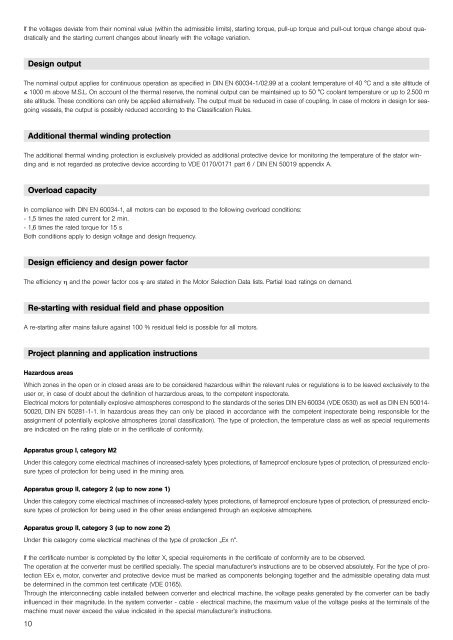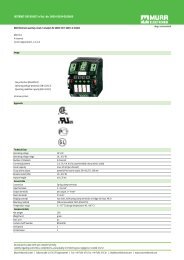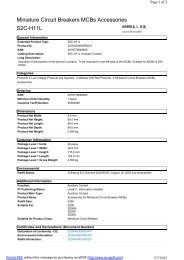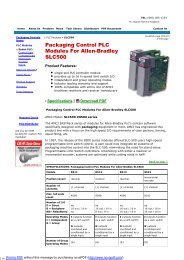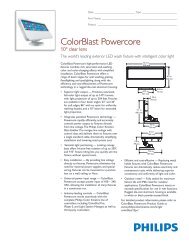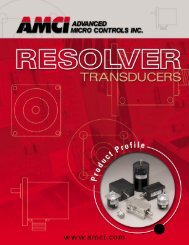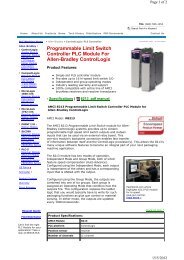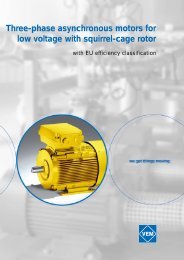for Explosive Atmosphere
for Explosive Atmosphere
for Explosive Atmosphere
- No tags were found...
Create successful ePaper yourself
Turn your PDF publications into a flip-book with our unique Google optimized e-Paper software.
If the voltages deviate from their nominal value (within the admissible limits), starting torque, pull-up torque and pull-out torque change about quadratically<br />
and the starting current changes about linearly with the voltage variation.<br />
Design output<br />
The nominal output applies <strong>for</strong> continuous operation as specified in DIN EN 60034-1/02.99 at a coolant temperature of 40 °C and a site altitude of<br />
≤ 1000 m above M.S.L. On account of the thermal reserve, the nominal output can be maintained up to 50 °C coolant temperature or up to 2.500 m<br />
site altitude. These conditions can only be applied alternatively. The output must be reduced in case of coupling. In case of motors in design <strong>for</strong> seagoing<br />
vessels, the output is possibly reduced according to the Classification Rules.<br />
Additional thermal winding protection<br />
The additional thermal winding protection is exclusively provided as additional protective device <strong>for</strong> monitoring the temperature of the stator winding<br />
and is not regarded as protective device according to VDE 0170/0171 part 6 / DIN EN 50019 appendix A.<br />
Overload capacity<br />
In compliance with DIN EN 60034-1, all motors can be exposed to the following overload conditions:<br />
- 1,5 times the rated current <strong>for</strong> 2 min.<br />
- 1,6 times the rated torque <strong>for</strong> 15 s<br />
Both conditions apply to design voltage and design frequency.<br />
Design efficiency and design power factor<br />
The efficiency η and the power factor cos ϕ are stated in the Motor Selection Data lists. Partial load ratings on demand.<br />
Re-starting with residual field and phase opposition<br />
A re-starting after mains failure against 100 % residual field is possible <strong>for</strong> all motors.<br />
Project planning and application instructions<br />
Hazardous areas<br />
Which zones in the open or in closed areas are to be considered hazardous within the relevant rules or regulations is to be leaved exclusively to the<br />
user or, in case of doubt about the definition of harzardous areas, to the competent inspectorate.<br />
Electrical motors <strong>for</strong> potentially explosive atmospheres correspond to the standards of the series DIN EN 60034 (VDE 0530) as well as DIN EN 50014-<br />
50020, DIN EN 50281-1-1. In hazardous areas they can only be placed in accordance with the competent inspectorate being responsible <strong>for</strong> the<br />
assignment of potentially explosive atmospheres (zonal classification). The type of protection, the temperature class as well as special requirements<br />
are indicated on the rating plate or in the certificate of con<strong>for</strong>mity.<br />
Apparatus group I, category M2<br />
Under this category come electrical machines of increased-safety types protections, of flameproof enclosure types of protection, of pressurized enclosure<br />
types of protection <strong>for</strong> being used in the mining area.<br />
Apparatus group II, category 2 (up to now zone 1)<br />
Under this category come electrical machines of increased-safety types protections, of flameproof enclosure types of protection, of pressurized enclosure<br />
types of protection <strong>for</strong> being used in the other areas endangered through an explosive atmosphere.<br />
Apparatus group II, category 3 (up to now zone 2)<br />
Under this category come electrical machines of the type of protection „Ex n“.<br />
If the certificate number is completed by the letter X, special requirements in the certificate of con<strong>for</strong>mity are to be observed.<br />
The operation at the converter must be certified specially. The special manufacturer’s instructions are to be observed absolutely. For the type of protection<br />
EEx e, motor, converter and protective device must be marked as components belonging together and the admissible operating data must<br />
be determined in the common test certificate (VDE 0165).<br />
Through the interconnecting cable installed between converter and electrical machine, the voltage peaks generated by the converter can be badly<br />
influenced in their magnitude. In the system converter - cable - electrical machine, the maximum value of the voltage peaks at the terminals of the<br />
machine must never exceed the value indicated in the special manufacturer’s instructions.<br />
10


